Most people don’t mind a few snails here and there, but when they’re covering every available surface in the tank, it can feel like a bit much.
Pest snails usually hitch a ride into display tanks on live plants. Try as you might, it can be easy to miss a tiny glob of snail eggs attached to a stem.
But don’t worry if you have pest snails, here are species which can be used to control outbreaks in your tank.
Best Snail Eating Fish
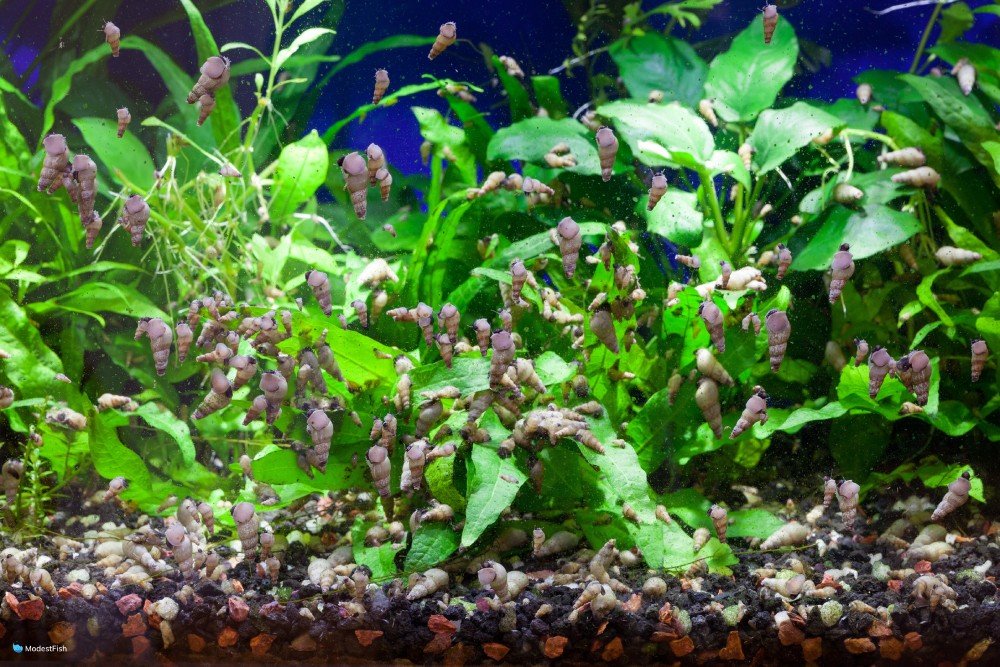
1. Zebra Loach
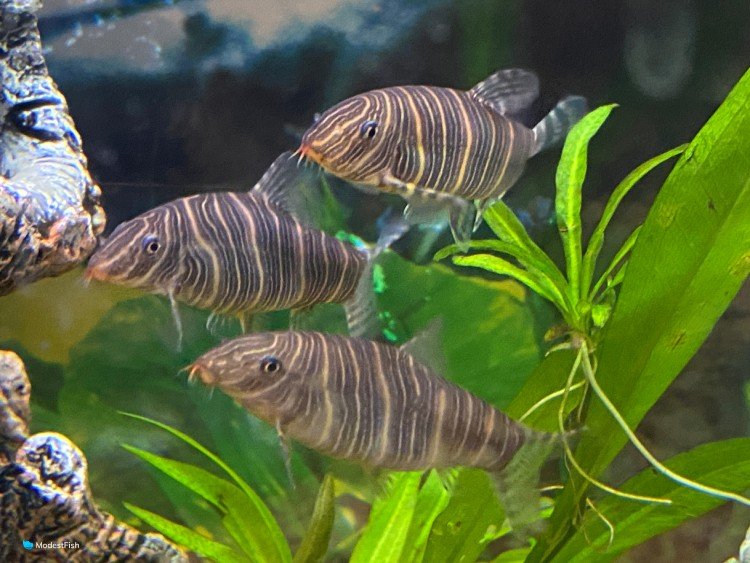
- Minimum tank: 40 gallon (151 liter)
- Size: 4 inches (10 centimeters)
- Temperature: 73°-79°F (23°-26°C)
- Diet: omnivore
- Behavior: peaceful shoaling, bottom dwelling fish
I put this fish at the top of the list deliberately. This species is my number one choice for a snail eating fish.
They’re beautiful and retain their gorgeous gray, gold and dark brown pinstripes their entire lives.
Also, zebra loaches only grow to be 4 inches long, compared to clown loaches that grow over a foot long.
Zebra loaches are a much more practical choice for the average aquarist to house long term. Do keep in mind, they need to be kept in a group of five or more.
And believe me, they will devour any snail in sight. They will systematically hunt down every last one.
They have specialized grinding teeth that let them crunch up any snail that will fit in their mouths. Any snail too big to fit in their mouths will be snatched out of their shells and eaten that way.
I highly recommend this species, I’ve kept them for years, and they are just a joy.
2. Yoyo Loach
- Minimum tank: 55 gallon (208 liter)
- Size: 6 inches (15 centimeters)
- Temperature: 75°-80°F (24°-27°C)
- Diet: omnivore
- Behavior: peaceful shoaling, bottom dwelling fish
This cousin of the zebra and clown loach is another great snail eating fish.
Please, keep in mind, these fish grow to be 6 inches in length and need to be kept in a group of five or more. So, they need at least a 55 gallon tank.
Life fish stores sell these fish as juveniles, and you may be taken with their striking black and white color in a pattern that spells ‘’yoyo’’ down their sides.
But, please note, these fish will look different as adults. Their color will change to a dark gray over a lighter gray. And the pattern will become more reticulated, making them look like they’re covered in gray camo.
They are still really neat looking, but if you’re mostly swayed by their juvenile coloration, just know it’s not going to stay that way forever.
Like zebra loaches, yoyos are great bottom feeders and are quirky, interesting fish.
3. Clown Loaches
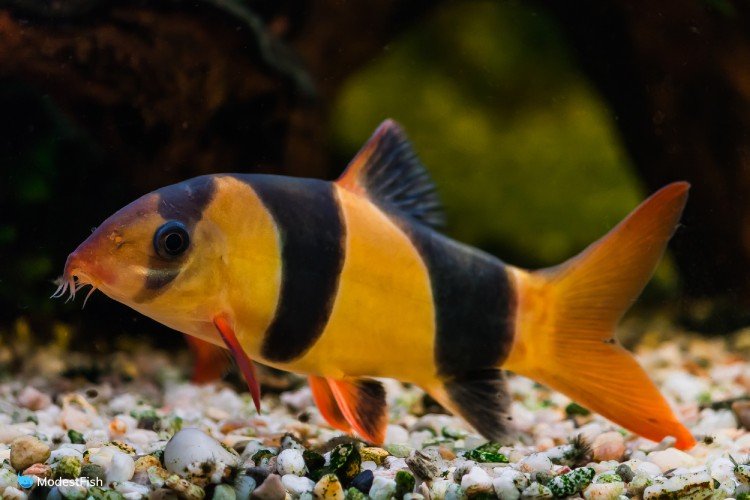
- Minimum tank: 150 gallon (568 liter)
- Size: 12 inches (30 centimeters)
- Temperature: 77°-82°F (25°-28°C)
- Diet: omnivore
- Behavior: peaceful shoaling, bottom dwelling fish
OK I don’t want to make it seem as if I don’t like clown loaches. I absolutely love these fish. They have great personalities. I could watch them all day.
But, they get HUGE and it’s just not practical for most hobbyists to house them. They need at least a 150 gallon tank. Clown loaches grow to 12 inches long and need to be kept in a group of at least five.
I’m an absolute aquarium nerd and I don’t have a tank that can accommodate this species. I wish I did, but my biggest tanks are only 55 gallons, way too small for clown loaches long term.
But, if you do have a tank that big, I highly recommend this species. A school of clown loaches is simply amazing. They shoal together and tumble over each other as they play and feed.
They will destroy any snails in the tank in short order.
Also though, just be aware, that as they age, clown loaches do not stay bright orange. They become a dusky sunset gold kinda color and their stripes become a less prominent brown.
They’re still cool looking, but they don’t have that same awesome bright tiger-like appearance after they mature.
4. Goldfish
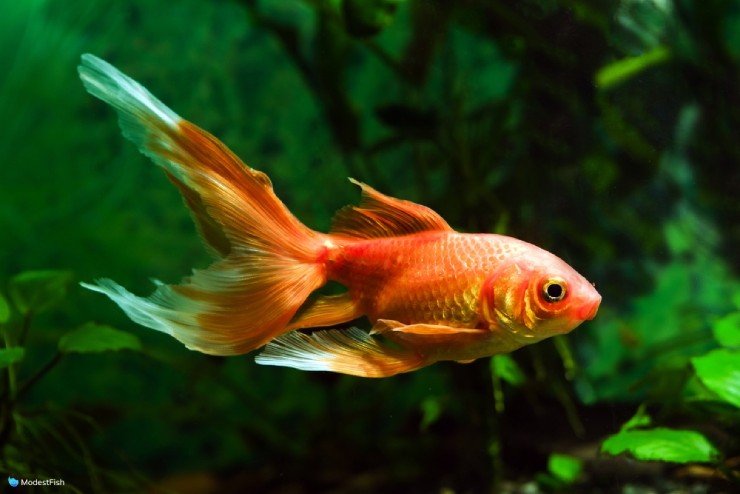
- Minimum tank: 40 gallon (151 liter)
- Size: 8 inches (20 centimeters)
- Temperature: 40°-75°F (4°-24°C)
- Diet: omnivore
- Behavior: peaceful but will eat smaller fish
Goldfish absolutely will go around and eat any snails that will fit in their mouths. These guys will eat just about anything that’s not nailed down as a general rule.
The problem is, goldfish are not good community fish. They add an enormous bio load to your system, they will swallow any fish smaller than them, and they need to be in an unheated tank, making them incompatible with most tropical fish species.
They are also notorious for uprooting, tearing apart, and devouring most life plants. So, they’ll turn any beautiful, garden – like, scaped tank into a barren desert within weeks, maybe even just days.
Goldfish can get the job done, they’ll eat up the snails, but they also might eat up your plants and other tank inhabitants. It’s got to be just the right kind of set up to use these guys.
5. Pea Puffer

- Minimum tank: 5 gallons (19 liters)
- Size: 1 inches (2.5 centimeters)
- Temperature: 74°-82°F (23°-28°C)
- Diet: carnivore
- Behavior: solitary, territorial, aggressive fish
Pea puffers are absolutely adorable and have awesome personalities.
I’ve often heard them referred to as “water puppies.“ They’re very aware of their surroundings, and will gladly interact with their human caretakers.
And they’re super small size means that they can live in something as small as a 5 gallon tank.
But, there are some drawbacks.
These little guys might look like an adorable, cartoon character, but they can be pretty downright mean. They have a hard beak on their mouth that can take chunks out of fins, flesh, or even eyeballs.
It’s generally best that you keep them in a species only tank. And in small tanks (under 15 gallons), you can probably only keep a single puffer as they can be quite territorial and aggressive with their own kind.
But, if you’re wanting to get rid of snails in a small planted tank, this fish will definitely do the job, and you’ll probably fall in love with it.
Once the puffer has beaten down the snail population, you will need to provide them with live and frozen foods, like bloodworms and shrimp.
Snail-Crusher Hap
- Minimum tank: 75 gallon (340 liter)
- Size: 10 inches (25 centimeters)
- Temperature: 75°-82°F (24°-28°C)
- Diet: omnivore
- Behavior: aggressive schooling fish, can only be kept with other Hap cichlids. For advanced fishkeepers only!
I only recommend these fish for fishkeepers with a lot of experience.
The snail – crusher hap can be quite hard to find, but if you have a snail problem in a Lake Malawi cichlid tank, these fish will get it taken care of for you.
Males grow to be 10 inches long, so they require quite a large tank.
A school should consist of one male and several females.
If you would like to keep other Lake Malawi cichlids, you’ll need at least a 150 gallon tank, as these fish can be quite territorial, especially when breeding.
The males have an eye-catching blue color and they’re very active and fiesty.
6. Assassin Snail
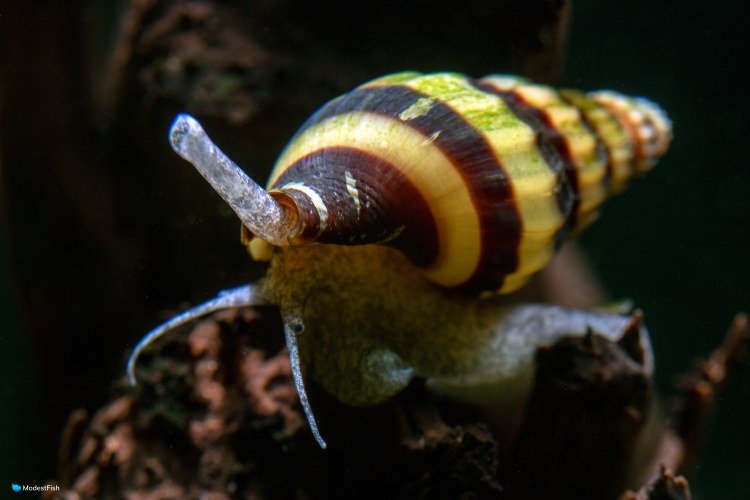
- Minimum tank: 30 gallon (113 liter)
- Size: 0.75-1.5 inches (2-3 centimeters)
- Temperature: 68°-80°F (20°-27°C)
- Diet: carnivore
- Behavior: predatory snail. Peaceful with fish but will eat invertebrates.
OK I will grant you. This one is not a fish, but they do eat snails.
Assassin snails are really neat looking with spiral shells with gold and brown stripes on them.
True to their name, they will scour the tank and eat any snails that they find.
They are too slow to harm healthy fish, but they will go after shrimp if they run out of snails.
But, assassins do breed pretty easily in an aquarium, albeit at a slower pace. So, you might trade one kind of snail population for another one.
But since they breed fairly slowly, assassins don’t overrun the tank like pest snails do.
They do have some value in the aquarium trade, unlike pond snails or bladder snails. You can collect adults and can maybe sell or trade them with other aquarists or mom-and-pop live fish stores.
And, although they’re good for cleaning uneaten fish food, be aware that they do not eat algae.
Where do pest snails come from in the first place?
Pest snails usually hitch a ride into display tanks on live plants. Try as you might, it can be easy to miss a tiny glob of snail eggs attached to a stem.
They can also ride in on decor from another tank, with bagged fish from the live fish store, even on filter media used to jumpstart a tank’s cycle.
Sometimes, the eggs will survive even a bleach dip.
Why do snail populations get out of control?
But, the snails need a food source in order for their numbers to get out of control. All those snails have got to be eating something.
So, a huge snail infestation means that something in the tank is out of balance. It could be that you’re overfeeding, a bunch of food is getting left by the fish, and the snails are happily munching on it for you.
It could be that your lights are too intense, or are left on too long, causing excess algae, and that’s what’s feeding the snails.
Long term, you’ve got to identify and cut off the snails’ food source to truly get rid of them.
And, if it’s excess algae that’s feeding them, you may introduce snail eating fish, only to find that you now have a massive algae problem, because you eliminated the snails that were keeping it at bay.
But, snail eating fish can definitely help you get rid of all the snails you already have while you figure out how to cut off their food source long term.
Keep Pest Snails Under Control
By and large, I think the best snail eating fish, especially if you have a tropical community tank, are loaches.
Most other snail eating fish, just do not make good community tank mates. Many have to be kept in a species only tank and aren’t a good fit for most existing setups.
Loaches, on the other hand, are great community fish, and are truly enjoyable to watch.
Just make sure that you keep them in as large a group as possible. Five would be the absolute minimum.
And make sure that you get a species that is suited to the size of your tank long-term.
Loaches are fairly hardy and undemanding and live a really long time. I think they are super cool.
I hope you find this article helpful.
I wish you and your fish the very best.
